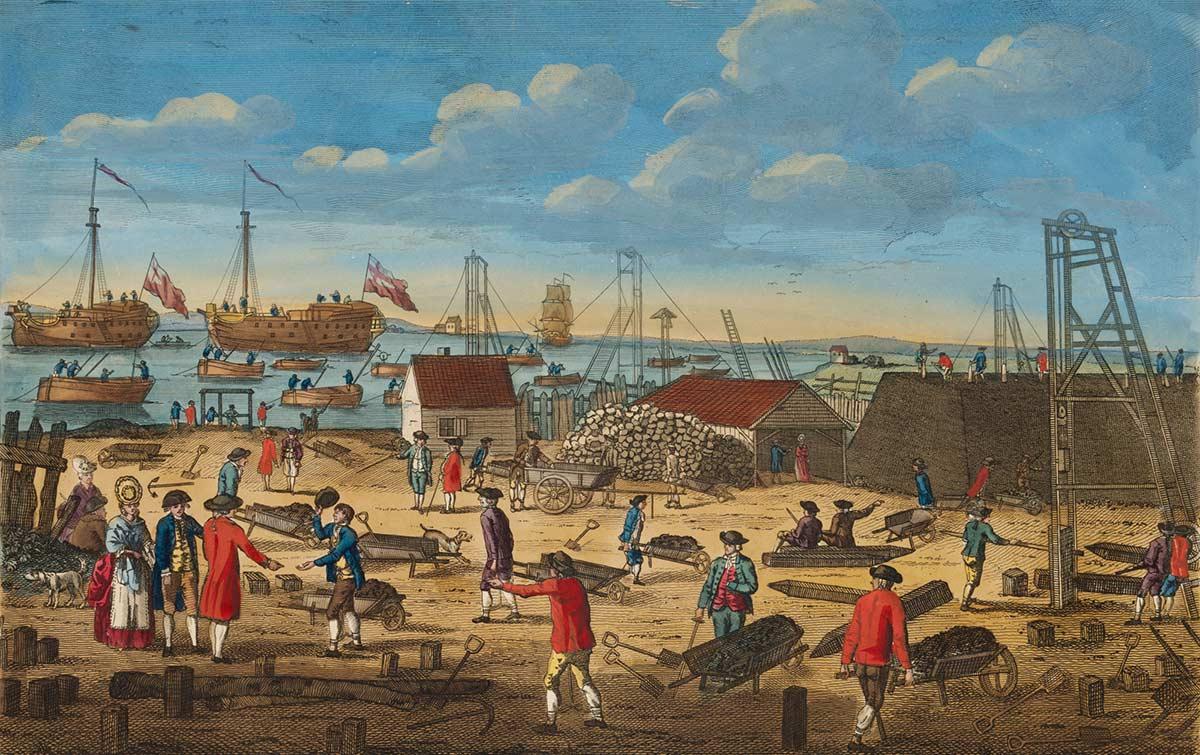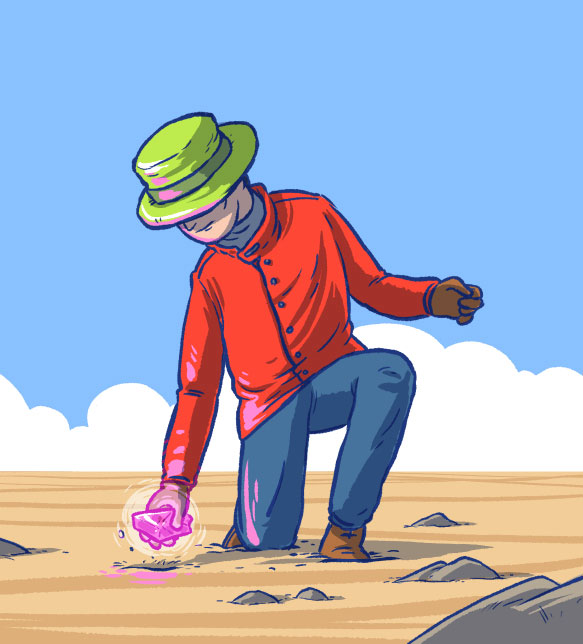
The Spiritstone Saga

- Year level 5
- Investigations 1
- Activities 27
- Curriculum topic Colonial Australia
The Spiritstone Saga: Choose your own learning adventure
A resource for Year 5 teachers and students
Ben Lawless, Aitken College, Victoria
The Spiritstone Saga is a ‘learning adventure’ where students learn about the history of Australia from 1770–1871. It is designed to fit in with the Year 5 History Curriculum — see Curriculum links for details.
1. What is a learning adventure?
- A learning adventure is a unique way of learning about a topic, where students learn through a first person narrative and choose their own path through the adventure.
- This learning adventure package and approach switches the learning from teacher-led to student-led.
- This learning adventure focuses on 15 defining moments in Australian history featured on the Digital Classroom.
- Content knowledge
- Students learn at their own pace by reading the adventure.
- They then do a content test quiz at the end.
- Historical skills
- The learning adventure contains the teaching of each skill, worked examples and exercises.
- The teacher then checks if they have done it correctly and if not, they guide students back to the material so that they can revise their responsesStudents can complete the learning adventure activities independently online.
- The activities have been designed to be easily printed or loaded to the class digital learning platform and interactive whiteboard by teachers. If the online option is chosen, students can save their work regularly to a suitable digital platform decided by the school/teacher.
- The activities can be completed in one go, or they can be staggered and completed over a period of time.
- Each time students finish an activity ‘assignment’ or end-of-section quiz they can save and email or print and show their teacher, reviewing their progress with their Learning Checklist spreadsheet.
- The teacher decides if the activity has been completed successfully — if so, this gets recorded on the Learning Checklist which tracks XP (experience points) and what level they have reached/
- If the activity hasn’t been done correctly, the teacher can guide students back to the material so that students can revise their responses.
- It is important that students ‘own’ the Learning Checklist so that interests and strengths are recognised, and areas for development encouraged and supported.
Benefits
- The learning adventure focuses on in-depth learning through:
- historically accurate and authentic narratives
- choice of a path through the narrative
- targeted development of HASS (History and Social Sciences) skills at each stage
- on-going review, reflection and evaluation processes and data tracking
- carefully designed, authentic real-world project-based learning.
- The learning adventure encourages:
- independent learning
- confidence with their own work
- problem-solving
- creative thinking.
- The learning adventure can be presented flexibly at each stage, and as independent or collaborative learning (a mixture of approaches is recommended to maximise engagement and depth).
- Student-centred; teacher facilitated
- The learning adventure promotes:
- engagement and motivation through competition (students can potentially see other students’ scores).
- differentiation and targeted teaching (use of Learning Checklist and constant feedback processes).
- interpretation of questions
- better retention of content knowledge (because it is taught as a first-person narrative and students find it easier to remember narratives).
- Game elements promote engagement, motivation and allow for easier constructive feedback because:
- students are used to making choices, there is a clear contextual situation, problem-solving, learn-as-you-progress and score-checks.
- students are used to responding to positive and constructive feedback on how to improve from gaming and digital mediums that many students are fluent and comfortable with.
2. How to run the learning adventure
- Ensure students are ready to make some adventurous decisions, then simply get them to work their way through the learning adventure
- They will have choices along the way, but the adventure has been designed so that they will all learn the same historical skills and core content knowledge no matter what choices they make.
- Each time a student completes an activity, they can save and email or print and show the teacher, with their updated Learning Checklist:
- If it has been done correctly, put a ‘1’ in the appropriate cell in the scoring spreadsheet.
- If it has been done incorrectly, guide students back to the material so that they can revise their responses.
- There are 15 unique sections in the learning adventure. There are 25 in total because some are repeated to allow for the different choices students can make. In reality students will only see each piece of content once.
Using the score sheet in the Learning Checklist
If you want to add a little friendly competition into the learning adventure (which can be very motivating for students), use the score sheet in the Learning Checklist spreadsheet and project the results on a projector as you play.
-
Type or paste in student names or student IDs.
-
Every time a student completes an activity, look at which section it is from. Put a ‘1’ in that cell in the spreadsheet.
-
It will then automatically give the student XP (experience points) and convert it into a level.
-
Scores:
| XP | Level |
| 0 | 1 |
| 100 | 2 |
| 200 | 3 |
| 400 | 4 |
| 700 | 5 |
| 1000 | 6 |
| 1500 | 7 |
| 2000 | 8 |
| 2500 | 9 |
| 3500 | 10 |
Map
- The map of the learning adventure below shows the content knowledge and the skill that will be learned in each section.

Rubric used
| Questions | Timelines | Sources | Viewpoints | Knowledge |
| Asks inferential question | Puts events on a timeline using correct spacing | Places source in historical context | Uses historical context to empathise with person from history | Explain knowledge |
| Ask open-ended question | Puts events on a timeline in correct order | Uses source to learn about history | Empathises with a person from history | Summarise knowledge |
| Asks literal question | Put events in correct order | Describes literal features of source | Recognises a viewpoint | List knowledge |
If a student completes the learning adventure, they will have completed activities for all of these levels.
3. Relevant Defining Moments
The learning adventure incorporates 15 of the Defining Moments in the Australia's Defining Moments Digital Classroom website:
| 1770 | ||
| 1788 |
Exile or opportunity? The First Fleet arrives at Sydney Cove |
|
| 1789 | ||
| 1791 | ||
| 1792 |
‘A brave and independent character’ — Pemulwuy resists the colonists |
|
| 1801–03 | ||
| 1815 | ||
| 1830 | ||
| 1833 | ||
| 1838 | ||
| 1854 | ||
| 1863 |
Protests against paternalism — Coranderrk Aboriginal Reserve established |
|
| 1868 | ||
| 1868 | ||
| 1871 |
School for politicians — Australian Natives’ Association formed |
Other Defining Moments in Australian history can be found on the Australia’s Defining Moments Digital Classroom interactive timeline
The National Museum of Australia would love to hear or see how you have used this learning adventure with your class, or how it has inspired you to use the decision-maker learning approach, or the Museum’s Defining Moments and other resources from Australia’s Defining Moments Digital Classroom. Teachers can contact us via the National Museum of Australia’s Contact us page.
4. Curriculum links
Australian Curriculum
Year 5 Humanities and Social Sciences
Inquiry and skills
Questioning
- Develop appropriate questions to guide an inquiry about people, events, developments, places, systems and challenges (ACHASSI094, ACHASSI122)
Researching
- Locate and collect relevant information and data from primary and secondary sources (ACHASSI095, ACHASSI123)
- Organise and represent data in a range of formats including tables, graphs and large-and small-scale maps, using discipline-appropriate conventions (ACHASSI096, ACHASSI124)
- Sequence information about people’s lives, events, developments and phenomena using a variety of methods including timelines (ACHASSI097, ACHASSI125)
Analysing
- Examine primary and secondary sources to determine their origin and purpose (ACHASSI098, ACHASSI126)
- Examine different viewpoints on actions, events, issues and phenomena in the past and present (ACHASSI099, ACHASSI127)
- Interpret data and information displayed in a range of formats to identify, describe and compare distributions, patterns and trends, and to infer relationships (ACHASSI100, ACHASSI128)
Evaluating and reflecting
- Evaluate evidence to draw conclusions (ACHASSI101, ACHASSI129)
Communicating
- Present ideas, findings, viewpoints and conclusions in a range of texts and modes that incorporate source materials, digital and non-digital representations and discipline-specific terms and conventions (ACHASSI105, ACHASSI133)
Knowledge and understanding: History sub-strand
- Reasons (economic, political and social) for the establishment of British colonies in Australia after 1800 (ACHASSK106)
- The nature of convict or colonial presence, including the factors that influenced patterns of development, aspects of the daily life of the inhabitants (including Aboriginal Peoples and Torres Strait Islander Peoples) and how the environment changed (ACHASSK107)
- The impact of a significant development or event on an Australian colony (ACHASSK108)
- The reasons people migrated to Australia and the experiences and contributions of a particular migrant group within a colony (ACHASSK109)
- The role that a significant individual or group played in shaping a colony; for example, explorers, farmers, entrepreneurs, artists, writers, humanitarians, religious and political leaders, and Aboriginal and/or Torres Strait Islander Peoples (ACHASSK110)
Victorian Curriculum
Level 5/6 History
Historical Concepts and Skills
Chronology
- Sequence significant events and lifetimes of people in chronological order to create a narrative to explain the developments in Australia’s colonial past and the causes and effects of Federation on its people (VCHHC082)
- Historical sources as evidence
- Identify the origin, content features and the purpose of historical sources and describe the context of these sources when explaining daily life in colonial Australia, reasons for migration and causes and effects of Federation (VCHHC083)
- Describe perspectives and identify ideas, beliefs and values of people and groups in the past (VCHHC084)
Continuity and change
- Identify and describe patterns of continuity and change in daily life for Aboriginal and Torres Strait Islander peoples,‘native born’ and migrants in the Australian colonies (VCHHC085)
Cause and effect
- Explain the causes of significant events that shaped the Australian colonies, contributed to Australian Federation and the effects of these on Aboriginal and Torres Strait Islander peoples and migrants (VCHHC086)
Historical significance
- Explain the significance of an event and an individual or group that influenced change in the Australian colonies and in Australian society since Federation (VCHHC087)
Historical Knowledge
The Australian colonies
- The social, economic and political causes and reasons for the establishment of British colonies in Australia after 1800 (VCHHK088)
- The nature of convict or colonial presence, including the factors that influenced changing patterns of development, how the environment changed and aspects of the daily life of the inhabitants, including Aboriginal and Torres Strait Islander peoples (VCHHK089)
- The effects of a significant development or event on a colony (VCHHK090)
- The role that a significant individual or group played in shaping and changing a colony (VCHHK092)
West Australian Curriculum
Knowledge and understanding
Year 4 History
First contacts
- Stories of the First Fleet, including reasons for the journey, who travelled to Australia, and their experiences following arrival (e.g. treatment of convicts, daily lives, social order)
Year 5 History
- The Australian Colonies
- The economic, political and social reasons for establishing British colonies in Australia after 1800 (e.g. the establishment of penal colonies)
- The patterns of colonial development and settlement (e.g. geographical features, climate, water resources, transport, discovery of gold) and how this impacted upon the environment (e.g. introduced species) and the daily lives of the different inhabitants (e.g. convicts, free settlers, Aboriginal and Torres Strait Islander Peoples)
- The economic, social and political impact of one significant development or event on a colony and the potential outcomes created by ‘what if ...?’ scenarios (e.g. frontier conflict; the gold rushes; the Eureka Stockade; the Pinjarra Massacre; the advent of rail; the expansion of farming; drought)
Humanities and Social Sciences skills
Year 5-6
Questioning and researching
- Develop and refine a range of questions required to plan an inquiry
- Locate and collect information and/or data from a range of appropriate primary sources and secondary sources (e.g.museums, media, library catalogues, interviews, internet)
- Record selected information and/or data using a variety of methods (e.g. use graphic organisers, paraphrase, summarise)
Analysing
- Use criteria to determine the relevancy of information (e.g. consider accuracy, reliability, publication date, usefulness to the question)
Interpret information and/or data collected
- (e.g. sequence events in chronological order, identify cause and effect, make connections with prior knowledge)
- Identify different points of view/perspectives in information and/or data (e.g. analyse language, identify motives)
- Translate collected information and/or data in to a variety of different formats (e.g. create a timeline, draw maps, convert a table of statistics into a graph)
Evaluating
- Draw and justify conclusions, and give explanations, based on the information and/or data in texts, tables, graphs and maps (e.g. identify patterns, infer relationships)
- Use decision-making processes (e.g. share opinions and personal perspectives, consider different points of view, identify issues, develop possible solutions, plan for action, identify advantages and disadvantages of different options)
Communicating and reflecting
- Present findings, conclusions and/or arguments, appropriate to audience and purpose, in a range of communication forms (e.g. written, oral, visual, digital, tabular, graphic, maps) and using subject-specific terminology and concepts
- Develop a variety of texts, including narratives, descriptions, biographies and persuasive texts, based on information collected from source materials
New South Wales Curriculum
Stage 3
Historical concepts
- Cause and effect: events, decisions or developments in the past that produce later actions, results or effects, e.g. events and other reasons that led to migration to Australia; reasons for the struggle for rights and freedoms for various groups in Australia.
- Perspectives: people from the past will have different views and experiences, e.g. differing attitudes of various groups to Federation or to granting rights and freedoms to women and Aboriginal peoples.
- Empathetic understanding: an understanding of another's point of view, way of life and decisions made in a different time, e.g. differing attitudes and experiences of living in an Australian colony; understanding the experiences of Aboriginal and Torres Strait Islanders, women and migrants throughout the twentieth century.
Historical skills
Comprehension: chronology, terms and concepts
- Respond, read and write to show understanding of historical matters
- Sequence historical people and events (ACHHS098, ACHHS117)
- Use historical terms and concepts (ACHHS099, ACHHS118)
Analysis and use of sources
- Compare information from a range of sources (ACHHS103, ACHHS122)
Perspectives and interpretations
- Identify different points of view in the past and present (ACHHS104, ACHHS123)
Research
- Identify and pose questions to inform an historical inquiry (ACHHS100, ACHHS119)
Explanation and communication
- Develop historical texts, particularly narratives and descriptions, which incorporate source material (ACHHS105, ACHHS124)
- Use a range of communication forms (oral, written, graphic) and digital technologies. (ACHHS106, ACHHS125)
The Australian colonies — Content
- Reasons (economic, political and social) for the establishment of British colonies in Australia after 1800 (ACHHK093)
- The nature of convict or colonial presence, including the factors that influenced patterns of development, aspects of the daily life of inhabitants (including Aboriginal and Torres Strait Islander peoples) and how the environment changed (ACHHK094)
- The impact of a significant development or event on a colony; for example, frontier conflict, the gold rushes, the Eureka Stockade, internal exploration, the advent of rail, the expansion of farming, drought (ACHHK095)
- The role that a significant individual or group played in shaping a colony; for example, explorers, farmers, entrepreneurs, artists, writers, humanitarians, religious and political leaders, and Aboriginal and/or Torres Strait Islander peoples (ACHHK097)
5. Learning at the National Museum of Australia
Enjoying our online teaching resources? Why not check out what else we have to offer?
We run onsite school programs, digital excursions and teacher professional learning programs.
Discover more about defining moments in Australian history through these curriculum-linked learning activities.






